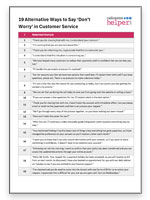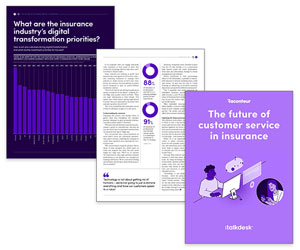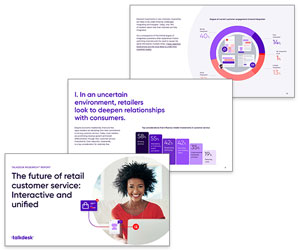When customers express concern, the default answer for many call handlers is ‘Don’t Worry’. This response is easy to say, but it can be interpreted as meaningless and dismissive.
Wouldn’t we all love to hear call handlers recognize the emotion and take steps to alleviate the issue instead?
Then look no further, as Helen Pettifer shares a selection of alternative responses to use instead.
Why Do We Feel Worried?

Feeling worried is our brain alerting us to uncertainty and the risk of negative outcomes. There is a sense of not being able to control the situation and the potential that we will face harm.
When worried, our mind is bombarded with persistent, unpleasant and unhelpful thoughts. We’re mapping out every worst-case scenario and it is difficult to suppress this way of thinking.
It consumes our minds, even when we try to distract ourselves. Therefore, when a customer expresses that they are concerned or worried about a decision or action, responding with ‘Don’t worry’ is ineffective.
Why Might a Customer Feel Worried?
So, why might customers feel worried when they contact your company? The processes, products and services are familiar to your team, so everything seems straightforward. And that’s why it’s easy for them to say ‘Don’t Worry’.
However, customers may have concerns, including:
- Affordability – With finances already tight, will decisions push me further into the red?
- The Process – When completing processes for the first time, will I do something wrong or be asked for something I don’t know?
- Judgement – Needing a specific service or having to share information is embarrassing. Will it alter the company’s opinion of me and might others find out?
- New Technology – Should I admit to not having a device or not knowing how to download and use an app?
- Data Sharing – If I tell you, will that information get into the hands of scammers or could my abusive ex use it to track me down?
Pressing issues such as financial struggles, stigma and fear will never be dismissed by ‘Don’t Worry’, so we need a fresh approach.
Appropriate Responses to Say to Worried Customers
I often hear call handlers saying ‘Don’t worry’ or ‘No problem’ as a filler phrase when they are unsure what to say or when there are uncomfortable gaps in the conversation.
These don’t help and can sound as though the customer is being cut short and is not important.
If the conversation ends, it is better to pause. This encourages the customer to add to their point, which might provide valuable information. It also gives call handlers a moment to prepare a more meaningful response.
To break the cycle of worry and help customers feel valued, call handlers should use responses that offer:
- Empathy
- Reassurance
- Solutions
- Empowerment
Responding to Worried Customers With Empathy
A call handler might choose to identify the emotion with empathy. This helps the customer to feel that they are being listened to and accepted.
- “Thank you for sharing that with me, I understand your concern.”
- “I’m sensing that you are worried about this.”
- “Thank you for informing me. I appreciate that this is a worry for you.”
- “I understand that this situation is concerning you.”
If you want more examples of empathy statements you can use in your customer conversations, read our article: Empathy Statements for Customer Service With Examples
Reassurance to Calm Worried Customers
Another approach is to offer specific reassurance. With these replies, the call handler indicates that they have understood the concerns and will help.
- “We have helped many customers to reduce their payments and I’m confident that we can help you too.”
- “I’ll handle this personally to ensure it’s resolved.”
- “Let me reassure you that we have two options that could help. I’ll explain them both and if you have questions, please ask. There is no pressure to make a decision today.”
- “I’m sorry that this was the reason for you contacting us today, but I can assure you that getting this sorted is my priority.”
We have more examples of reassurance statements for customer service. Read our article: Reassurance Statements in Customer Service – With Examples
Practical Responses to Address Concerns
Problem-solving typically follows an empathic or reassuring response. However, in certain situations, the call handler might get straight to the point.
A focus on actions is an effective way to change the customer’s thought process from worries to practicalities.
- “We can set that up during the call today to save you from going onto the website or calling us back.”
- “If you can answer a few questions for me, I’ll explain which is the best option.”
- “Thank you for sharing that with me. I have frozen the account with immediate effect. Can you please email or send me the paperwork and then I can process your request.”
- “We’ll go through every step of the process together, so you know nothing has been missed.”
Responses to Help Callers Take Control
Returning to the fact that worry is often caused by a feeling of loss of control, a call handler can also help to reduce customer concerns through empowerment.
What would enable the customer to handle this situation with greater confidence?
- “How can I make this easier for you?”
- “After this call, I’ll send you a video link/audio guide/infographic which explains everything step by step.”
- “You mentioned finding it hard to keep track of things since everything has gone paperless, so I have changed the preference on your account so you’ll receive a letter each month.”
- “I want you to know that I can only record information with your consent, so if you want to share something in confidence, it doesn’t have to be noted on your account.”
Follow-Up Responses
Having empathized, reassured, problem-solved and/or empowered, there is another step to convince the customer that everything is in hand.
That is to confirm when actions have been undertaken. It is helpful to be told that something can or will be done, but the worries will only be silenced when the customer knows their concerns are resolved.
- “Following our call this morning, I want to confirm that your policy has been transferred and you can access the updated documents through your online account.”
- “Hello, Mr Smith. Your request for a payment holiday has been accepted, so you will receive no bill from us next month. As discussed, I have also booked an appointment for you with our debt advisor on Tuesday to see if you are entitled to any financial support.”
- “I’ve checked and you do need to come into the branch with two forms of ID for us to action your request. I appreciate this is difficult for you, but we are open until 7pm on Wednesdays.”
Printable – 19 Alternative Ways to Say ‘Don’t Worry’ in Customer Service with Example Statements
Do you want to download this to share with your team?
Get your 19 Alternative Ways to Say ‘Don’t Worry’ in Customer Service with Example Statements now:
There Are Plenty of Better Responses Than “Don’t Worry”
There is no situation where saying “Don’t worry” is helpful! Therefore, call handlers need to replace it with responses that help customers feel their concerns have been heard and addressed.
I invite you to build on the examples shared in this article to give your team appropriate alternatives.
What phrases do you use in your contact centre? Reach out to us on LinkedIn and let us know!
Written by: Helen Pettifer, Director of Helen Pettifer Training Ltd and a specialist in the fair treatment of vulnerable customers.
For more on customer service language, read our articles:
- 100 Complimentary Words and Phrases to Use in Customer Service
- Assurance Statements in Customer Service – With Examples
- 15 Great Alternatives to “Sorry for the Inconvenience”
Author: Helen Pettifer
Reviewed by: Megan Jones
Published On: 27th Aug 2024 - Last modified: 16th Sep 2024
Read more about - Skills, Call Handling, Customer Service, Downloads, Editor's Picks, Helen Pettifer, Language, Printable, Top Story








































